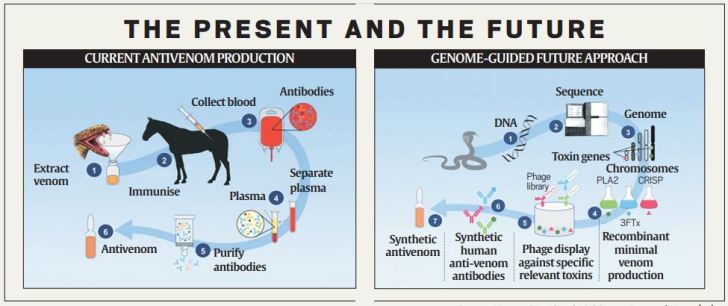Note4Students
From UPSC perspective, the following things are important :
Prelims level: Antivenom
Mains level: Genome sequencing and its applications
This week, an international team of researchers reported that they have sequenced the genome of the Indian cobra, in the process identifying the genes that define its venom. This has provided a blueprint for developing more effective antivenom.
Big four in Snake bites
- India alone accounts for about 50,000 deaths annually, and these are primarily attributed to the “big four”.
- The challenge has been producing antivenom for the species known collectively as the “big four” — the Indian cobra (Naja naja), common krait (Bungarus caeruleus), Russell’s viper (Daboia russelii), and saw-scaled viper (Echis carinatus).
- In India, common antivenom is marketed for the treatment of bites from the “big four”, but its effectiveness is questionable.
- While the common antivenom worked as marketed against the saw-scaled viper and the common cobra, it fell short against some neglected species and also against one of the “big four” — the common krait.
- Accidental contact with snakes leads to over 100,000 deaths across the world every year.
What is antivenom?

- Antivenom is currently produced by a century-old process — a small amount of venom is injected into a horse (or a sheep), which produces antibodies that are then collected and developed into antivenom.
- This is expensive, cumbersome and comes with complications. Some of the antibodies raised from the horse may be completely irrelevant.
Why has production of effective antivenom been challenging?
- Venom is a complex mixture of an estimated 140-odd protein or peptides.
- Only some of these constituents are toxins that cause the physiological symptoms seen after snakebite.
- But antivenom available today does not target these toxins specifically.
Issues with present antivenom
- The horse also has a lot of antibodies floating in its blood that have nothing to do with the venom toxins.
- One more problem with horse antibodies — our immune system recognises it as foreign and when antivenom is given our body mounts an antibody response. This leads to what is called serum sickness.
- Also, next time if one is unlucky and has a snakebite incident (even if it is a different snake) and they are given a horse-derived antivenom, the body is going to have a severe allergic reaction.
How does decoding the genome help?
- In the Indian cobra genome, the authors identified 19 key toxin genes, the only ones that should matter in snakebite treatment.
- They stress the need to leverage this knowledge for creation of antivenom using synthetic human antibodies.
- Targeting these 19 specific toxins using synthetic human antibodies should lead to a safe and effective antivenom for treating Indian cobra bites.
Back2Basics
Genome Sequencing
- Genome is an organism’s complete set of DNA, including all of its genes.
- Each genome contains all of the information needed to build and maintain that organism. In humans, a copy of the entire genome—more than 3 billion DNA base pairs—is contained in all cells that have a nucleus.
- Genome sequencing is figuring out the order of DNA nucleotides, or bases, in a genome—the order of As, Cs, Gs, and Ts that make up an organism’s DNA.
Get an IAS/IPS ranker as your 1: 1 personal mentor for UPSC 2024
